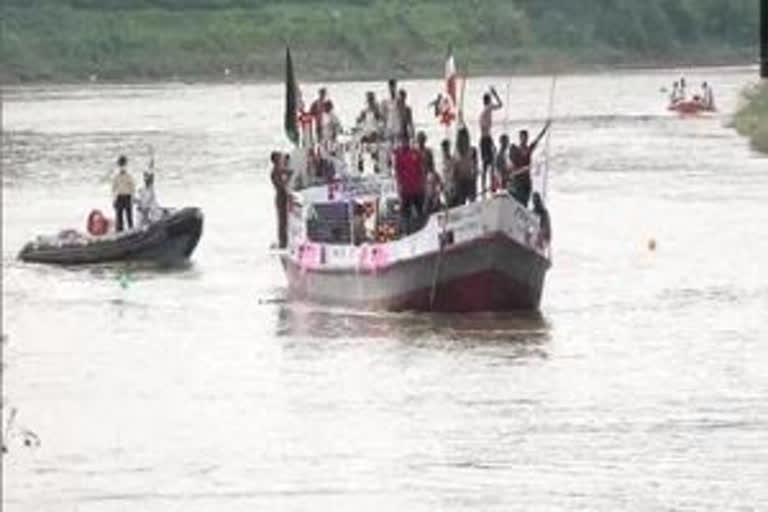New Delhi: The Inland waterway route has brought a new dawn in the trade history of Tripura as the state opens its first-ever inland waterway with Bangladesh from Sonamura in Sepahijala district.
However, along with the expectations and hopes, there are also questions around the ambitious project and how it will boost Tripura's trade potential and India's as a whole.
Experts say that with the introduction of the new Indo Bangladesh Protocol route, Tripura is expected to gain economically as exporters are likely to rise.
Speaking to ETV Bharat, Joyeeta Bhattacharjee, an expert on Bangladesh at the Observer Research Foundation, a Think Tank in Delhi said, “Beginning of the new Indo- Bangladesh protocol route is welcoming. It creates an additional connectivity route to Ashuganj which is considered a key point in the inland water connectivity between India and Bangladesh. Tripura is expected to gain economically as exporters are likely to rise. Also, it can earn from the transit charges."
“Due to heavy siltation in the river, it will be operated only for four months. So it cannot be an all-weather route. Therefore, there is a need to make it all-weather route to enjoy the benefit to its fullest potential. Dredging of the river will be necessary to increase its navigability", she suggested.
On Saturday, a big vessel carrying a cargo of cement from Bangladesh’s Munshiganj port arrived at Sonamura port in Tripura’s Sephahijala district.
Around 25-30 per cent of transportation cost would be saved if goods are transported via waterway, It will reduce the cost of transportation to North Eastern states, Joyeeta added.
Also read: Army starts process to make ICVs capable of operating in night
The Sonamura (Tripura)-Daudkandi (Bangladesh) route was included in the Indo-Bangladesh Protocol (IBP) routes signed by Indian high commissioner in Bangladesh, Riva Ganguly Das, and Bangladesh shipping secretary, Mohammad Mesbah Uddin Chowdhury, at Dhaka this May. The ambitious project has already been projected by Tripura’s incumbent BJP-IPFT government as a major catalyst to catapult Tripura into a gateway to the North-East.
According to a survey conducted by the Bangladesh authorities, 89.5 kilometres out of the 90 km of the Sonamura-Daudkandi protocol route falls in Bangladesh and the remaining 500 metres falls in India.
“Protocol for Inland Water Trade & Transit (PIWTT) was signed in 1972. However, the new route is expected to provide a cheaper mode of transporting goods which is nearly 30% of the cost and reduces time taken for transportation by 50 %”, Smruti S Pattanaik a research fellow at the MP-IDSA, specialized in South Asia told ETV Bharat.
She says that it has the potential to enhance foreign trade/bilateral trade because it takes the river route and avoids the difficult terrain of the North East where transportation takes a few days. Thirdly, to some extent, it will help boost business. “I agree that utilizing the inland waterways to its optimum would surely enhance trade and give a boost to local trade and create employment opportunities especially for those employed in loading, unloading and transporting goods. It is going to have multimodal transport ”, Pattanaik added.
As part of the riverine trade route, vessels will travel on the river Gomati — Tripura’s longest river, which crisscrosses through several districts before merging with river Meghna in Bangladesh. A permanent jetty is to be built in Sonamura for the loading and unloading of goods, with a temporary floating jetty which currently in place.
Further, Joyeeta Bhattacharjee underlines that Bangladesh is an important partner in Act East Policy and connectivity is given emphasis under AEP. Any effort in strengthening connectivity strengthens AEP. “One important aspect of inland waterways is that it is one of the eco-friendly means of communication. Given the ecological sensitivities of the NE region, such steps help to blend economic development in an eco-sensitive manner. Proper implementation could go a long way in reducing pressure on the roads. However it is too early to say anything”, she said.
Also read: ICICI-Videocon case: ED arrests Deepak Kochhar over money laundering allegations
It is pertinent to note that Tripura borders Bangladesh and it is surrounded by Bangladesh on its north, south and west: the length of its international border is 856 km (84 per cent of its total border). The official trade between Tripura and Bangladesh started in 1995-96. The total volume of trade has increased manifold from a meager Rs. 4.12 crores during 1995-96 to about Rs. 537.08 crores during 2018-19. In addition, during 2016-17, 663 million units of power of value 366 crores exported to Bangladesh.
India’s External affairs minister S Jaishankar with his Bangladesh counterpart A.K. Abdul Momen will have a virtual meeting later this month as New Delhi and Dhaka are looking at taking their bilateral ties forward and not involve a third country.
The JCC is the highest form of bilateral mechanism between India and Bangladesh, co-chaired by the foreign ministers, encompassing all aspects of the relationship from business to security collaboration.


